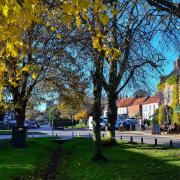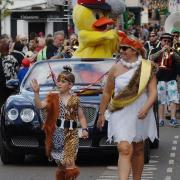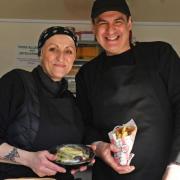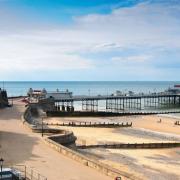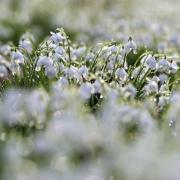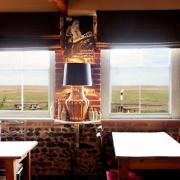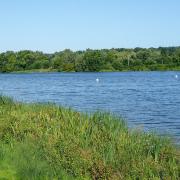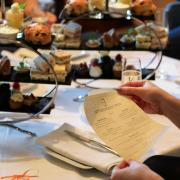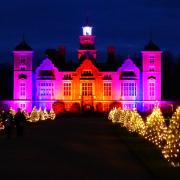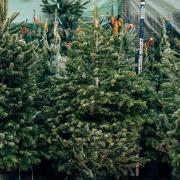From winter crocuses, to summer time penstemons, the 55 acres of gardens at the National Trust’s Blickling Estate have been designed with monthly “must-sees” in mind, meaning there is always something new to discover. So whether a game of croquet on The Acre whets your whistle or knowing all the Latin names for our blooms is more your thing, there’s a whole host of fantastic spaces for you to explore this June.
The parterre
What is it?
A parterre is a formal garden typically landscaped in symmetrical patterns, separated and connected by gravel pathways. Popular in English stately homes, a parterre created a show of splendour and wealth.
Who looks after it?
Gardener Steve Hagon is the go-to guy for the parterre, though maintaining the lawns and hedges is a real group effort.
What’s best in June?
Our blue flowers, Baptisia and Campanula will be in bloom. Running through the yew hedge “maze” on a fine summer’s day is a must-do for young and old alike.
The double borders
What are they?
The double borders are flowerbeds on the south side of the parterre, bordering walkways on each side. We’ve used garden designer Norah Lindsay’s (1873–1948) understanding of form and use of colour to create them.
Who looks after it?
Gardeners Rob Wiskin plants penstemons to create a carpet of summer colour and Katy Watkins also propagates seeds for the double borders.
What’s best in June
The penstemons with their trumpet-shaped blooms look fantastic. Traditionally cool coloured flowers were planted in the distance with warmer hues in the foreground – except at Blickling where we have stayed true to Norah Lindsay’s original designs using cool colours towards the front of the house.
The orangery and the orangery garden
What is it?
Hinting at classical architecture, orangeries were a fashionable addition to any stately home. We grow a plethora of fruits such as lemons, oranges, limes, grapefruits and kumquats.
Who looks after it?
Ed Atminson, another gardener, watches over the orangery and the citrus trees inside. The orangery garden is maintained by our large band of volunteers.
What’s best in June?
The citrus trees are brought outside in June - as the risk of frost will have passed. Relish your chance to smell the summer sun ripening the fruits.
The walled garden and kitchen garden
What is it?
The original kitchen gardens for the house; we’re returning some of the space back to its original function and growing produce for our own restaurant.
Who looks after it?
Katy’s currently growing all sorts of vegetables such as broad beans, onions, pumpkins and sweetcorn.
What’s good in June?
In June you can really see what’s growing, with the promise of vast quantities of vegetables ready for our restaurant! Don’t forget to visit the bean house in the kitchen gardens.
The dell
What is it?
The dell garden has been created using an existing bowl-shaped crater within the land, possibly formed when earth was taken to build up the banks of the ha-ha.
Who looks after it?
This area is looked after by our two longest serving volunteers, Terry and Sandy.
What’s good in June?
This space is very tranquil with soft planting and gentle colour schemes, and the Bug Hotel will be home to lots of interesting mini-beasts.
Rose and philadelphus garden
What is it?
Two gardens to really focus on the senses - one with beautiful rambling roses, the other with sweet smelling philadelphus plants. The perfect places to take time out and reflect.
Who looks after it?
Managed by Steve, who has been at Blickling for 42 years.
What’s good in June
Flowering in the early summer months - you will smell it before you see it!
The acre and the wilderness
What is it?
Once a pleasure-pond in the 1760s, this area is perfect for families, with ancient Turkey oaks and oriental plain trees to climb and outdoor games to play.
Who looks after it?
Ed and Rob look after the grass, but this area is a real team effort.
What’s good in June?
Indulge your competitive side with a game of giant Jenga, Connect Four or croquet.
The avenues
What are they?
Avenues were a popular feature for the stately home, as they allowed residents to admire their estate from all the best vantage points, and impress any guests invited to stay. Our avenues are lined with different native tree species including lime, oak, and beech.
Who looks after this?
Trees are checked and monitored regularly. The whole team is involved in pruning.
To see in June
Stand at the mid-point, where the major tree-lined avenues coincide and take a moment to look down each vista. Identify the native tree species or see who comes first in a race down the avenues.
The garden is open daily from 10.15am to 5.30pm, with volunteer garden tours twice a day, every day; www.nationaltrust.org.uk/blickling-estate/things-to-see-and-do/gardens




